Los Angeles is the place where the American dream is being lived. The beautiful location with warm climate and the Pacific Ocean helps to further sweeten the joyous life that prevails in the now very large American city.
When you say Los Angeles, you have to say Hollywood and all the movie productions going on here. It is the city of dreams, and everything is possible in Los Angeles, which as a tourist you get the feel of in the city’s exclusive neighborhoods like Hollywood and Beverly Hills.
Los Angeles is spreading in a very large area, but this has not always been the case. This allows you to continue to visit the city center and what constitutes the old town with El Pueblo as one of the main sights.
The Los Angeles area is also a place with plenty of opportunities for a rich variety of attractions and entertainment. Amusement parks are like pearls on a leash, and the area also offers some fine museums. If you want to get out of the city, there are among other national parks, large desert areas, the Pacific, San Diego and Mexico at a short distance.
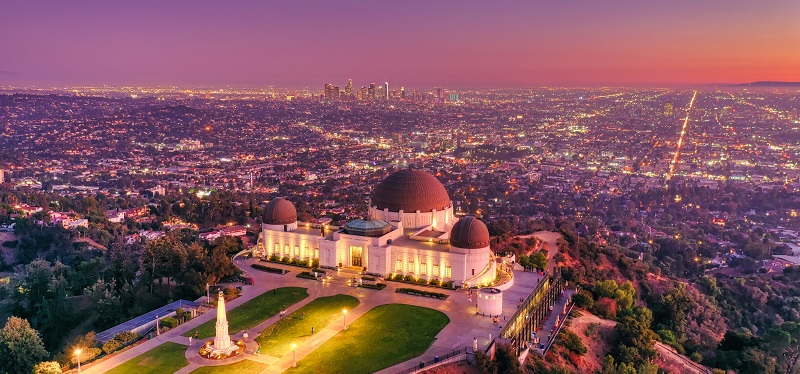
The Griffith Observatory is an observatory that opened in 1935 in Griffith Park on the south side of the Mount Hollywood ridge. The trip up to the Griffith Observatory alone is interesting because the view of the area’s hills and a panoramic view of all of Los Angeles spreads out at one’s feet.
In the observatory itself, there are exciting exhibitions on several floors. The sky and the universe are the focal point, and in the exhibition there are lots of effects from the world of science. You can also see a space exhibition, where the Earth and the planets of the Solar System are reviewed in terms of appearance, gravity and other factors that give knowledge and impressions of our immediate surroundings in the universe. Various films are also shown in the space theatre.
The Civic Center is the administrative heart of Los Angeles and also serves as the urban center for the northern part of downtown Los Angeles. It is also the place where some federal institutions sit side by side with agencies from the state of California and the city of Los Angeles.
The many imposing administration buildings are located around the recreational area Grand Park, which was newly constructed and opened in 2012; formerly the green area was called Civic Center Park. Grand Park stretches from Los Angeles City Hall in the southeast to the Music Center in the northwest. In the area, there are a number of interesting buildings on all sides of Grand Park.
Standing in front of Los Angeles City Hall facing the Music Center is the Los Angeles County Criminal Courts on the right. In the mid-1800s, there was a school here and later a former courthouse, which was destroyed by an earthquake in 1933. On the opposite side of Grand Park, the State Building stood opposite the Los Angeles County Criminal Courts until 1975. It was a 56-meter high art deco building from 1933, which had to be demolished due to structural danger such as collapse after an earthquake in 1971.
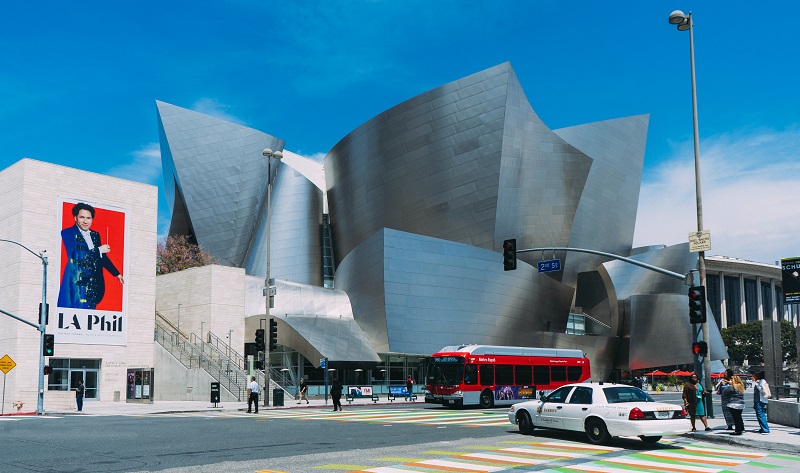
The Walt Disney Concert Hall is part of the Los Angeles Music Center and at the same time a unique architectural gem that plays with the senses both externally and internally.
Behind the construction was Lillian Disney, who was the widow of the creator of, among others, Donald Duck, Walt Disney. She donated the first 50 million dollars as a gift to the city and as a tribute to Walt Disney’s contribution to the arts and creativity in the city.
The building was designed by Frank Gehry and completed in 2003 with Minoru Nagata’s acoustic design. The characteristic shapes and the outer metal are the architectural characteristics of the building, which also impresses with its beautiful auditorium, where more than 2,200 spectators can listen to, among others, the Los Angeles Philharmonic and the Los Angeles Master Chorale.
From the beginning of the 20th century, Los Angeles developed into a leading American cinema and theater city. It happened in the area around the street Broadway, where many theaters were built until the 1930s. You can still experience these entertainment venues in the so-called theater district; Broadway Historic Theater and Commercial District. The theaters are characterized by their beautifully decorated exteriors, where on closer inspection you can imagine the time of active ticket sales in the pavilions at the street entrances.
There are three of the former movie theaters as neighboring buildings at the addresses 518 South Broadway, 528 South Broadway and 534 South Broadway. There are also theaters located elsewhere along Broadway, so these three are just examples from different decades.
The Roxie Theater (518 S Broadway) opened in 1932, making it the last major motion picture theater to open in Los Angeles’ Broadway neighborhood. The cinema had room for 1,600 spectators, and the building was constructed in a beautiful art deco design by John M. Cooper.
The Cameo Theater (528 S Broadway) is a movie theater building that opened in 1910 on Broadway. Quite atypically, the building was built for the playback of films and not also as a theater with live performances. There was, however, a small stage where an orchestra could stand to accompany the silent films of the time. The cinema was in operation until 1991, and for part of the years the place was a so-called Nickelodeon cinema. It was a type of movie theater where you paid a nickel to see a movie.
The Arcade Theater (534 S Broadway) was built in 1910 and was then called the Pantages after Alexander Pantages, who operated a series of movie theaters and theaters. The Pantages on Broadway could seat 1,400 spectators, and they could see films and some of the stars of the day live; for example, Stan Laurel performed here in 1919. In 1925 the theater was sold to the Dalton brothers, and in 1928 the venue changed its name to the Arcade Theatre. Like many other theatres, the Arcade also closed, whose foyer is set up as a business today.
Hollywood Boulevard is one of the USA’s most famous streets, and it is known from countless films such as Pretty Woman. The long street is also called De Bristede Drømmes Boulevard/Boulevard of Broken Dreams. The nickname comes from the time when film looked elsewhere than Hollywood, and those left behind were those who had not been successful.
In the years 1887-1910, the street was called Prospect Avenue. At the time, it was part of the city of Hollywood, which, with its incorporation into Los Angeles in 1910, became the setting for, among other things, the street’s name change. Today, very large sums have been invested in giving the street its life and attractiveness from the heyday of the 1920s. Many buildings have been renovated to their former beauty and new entertainment centers have been added. Events such as the annual Oscars also take place here.
The old movie theaters on Hollywood Boulevard are something special. In Hollywood’s infancy, the theaters were the center for launching and showing the big movies of the time, and they were among the meeting places for the celebrities of the city. Today, some of the once close to 500 theaters and cinemas are experiencing a renaissance that you can experience for yourself. Some of the theaters can be seen by strolling along Hollywood Boulevard from the Hollywood/Vine subway station west to Hollywood/Highland.
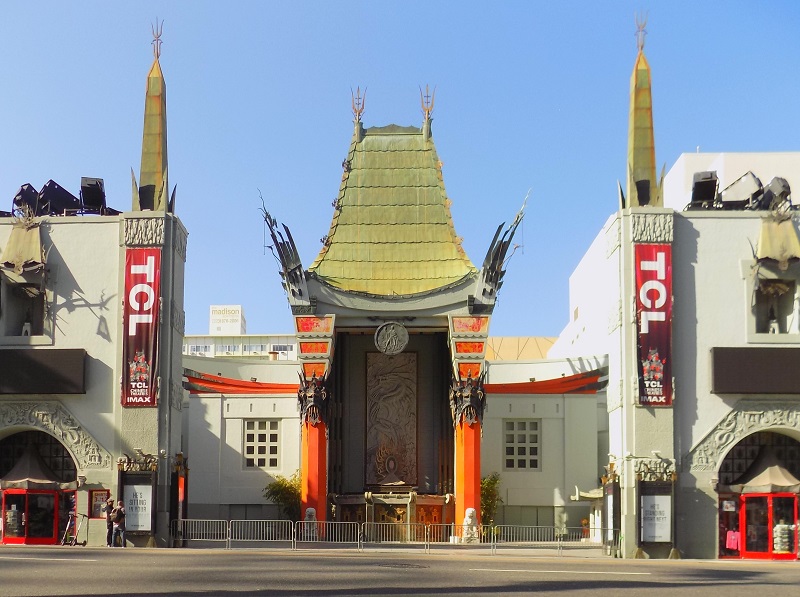
The Chinese Theater is almost Hollywood’s tourist center and the epitome of film city glamour. The theater was built by the impresario Sid Grauman in 1926-1927 in a grand Chinese-inspired style as a sumptuous place to premiere the great films of the time. The construction was done in collaboration with Charles E. Toberman, with whom Grauman built three theaters.
The theater was called Grauman’s Chinese Theater and was built after the success of the nearby Grauman’s Egyptian Theatre. The theater was the big thing through the Hollywood of the 1930s and 1940s. The Oscars were held here in 1944, 1945 and 1946, and several later blockbusters have premiered on the cinema screen. This applies, for example, to George Lucas’ Star Wars in 1977.
In front of the theater is a row of tiles where celebrities have left handprints and footprints and written their names over time. The list of names is long, and the place is also the starting point for the star parade Hollywood Walk of Fame. The hand and footprints are supplemented in several places with, among other things, a gun and horseshoe, which characterized the careers of the celebrities concerned. Imprints continue to be placed in front of the theatre, and among the newer ones are stones with the three main actors from the Harry Potter films.
Along Wilshire Boulevard is the green oasis Hancock Park, where you can see the La Brea Tar Pits, a group of naturally occurring asphalt lakes. The asphalt bubbles up right here, and throughout history, for example, bones from animals have sunk into and been protected by the asphalt, which has resulted in various finds in the lakes. These finds are on display at the Page Museum next to the asphalt lakes.
The lakes you can see today are the result of the site being used, so to speak, for an asphalt mine during Los Angeles’ construction period. Especially in the decades after 1900, there was a lot of activity here, where there were derricks in the surroundings of the lakes.
Today, you can walk around the park and see the asphalt lakes that lie like pearls on a string on the circuit in Hancock Park. The largest of the lakes is located towards Wilshire Boulevard, and here you can clearly feel the characteristic smell of asphalt, which is constantly in the air.
The Page Museum is located at the La Brea Tar Pits and is part of the Los Angeles Museum of Natural History. The museum opened in 1977, and here you can see the history and natural science behind the asphalt, and you can see the many exciting discoveries that have been made in the asphalt lakes over the years. This applies, among other things, to a skeleton from a mammoth.
The Los Angeles County Museum of Art is one of America’s leading art museums, and its collection numbers more than 100,000 works. You can see modern art by, for example, Paul Klee, Alberto Giacometti and Pablo Picasso. Of contemporary art, Joan Miró and Jeff Koons are among the artists in the collection, which also includes Etruscan, Greek and Roman art, Asian and South American works, design, installations and much more. European painting is also represented with works by, among others, Rembrandt, Titian, Cézanne, Monet and Gauguin.
In short, there is something for every art lover at the Los Angeles County Museum of Art, and you can also enjoy some of the art by simply walking around the museum. In front of the museum and along Wilshire Boulevard, you can see Chris Burden’s installation Urban Lights, which is from 2008. The installation consists of 202 street lamps from the 1920s and 1930s, which Burden began collecting in the year 2000. It is a breathtaking sight both day and night, when walking around between the lamps.
Immediately east of Urban Lights, you can enjoy a fantastic sculpture garden, where a number of Auguste Rodin’s bronze sculptures are on display between lawns and palm trees. On the opposite side of Wilshire Boulevard seen from the Rodinhaven, you can see ten erected pieces of the Berlin Wall, which in its time divided Germany into East Germany and West Germany. The display is the largest in the world outside of Germany, and the monument is part of the Wende Museum, a Cold War museum based in Culver City, California.
Behind the art museum seen from Wilshire Boulevard, you can see the sculpture Levitated Mass, created by Michael Heizer in 2012. The sculpture is an installation consisting of a 340 ton rock block placed over a concrete substructure where you can walk and see the rock block above one’s head.
The Los Angeles County Museum of Art is also known as LACMA. It was founded as a museum in 1961 and it was local architect William Pereira who was chosen for the task of designing the museum building. Over the years, the museum and its collections grew; not least due to large private donations that have enabled the purchase of the distinguished collection that you can experience today.
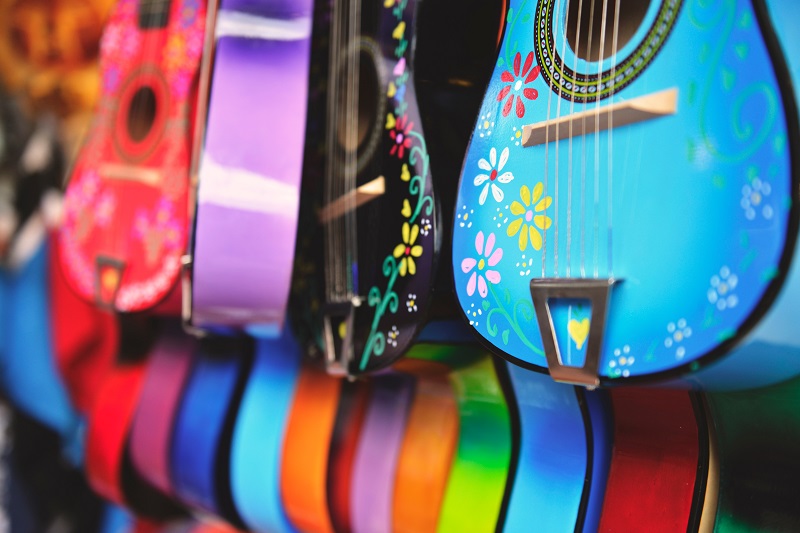
North of The Plaza is Olvera Street, which was the central street in the construction of the Spanish El Pueblo de Los Angeles. In its early days, Olvera Street was a busy street in the growing city, and many houses were built around it over time.
Today, the street has been transformed into a pedestrian street with an extensive street market. Here there are stalls, shops and eateries, and the whole is quite enjoyable. At the same time, it is possible to sense the historic Los Angeles behind the many stalls.
Among other things, you can see Los Angeles’ oldest house in Olvera Street. It is the Avila Adobe (10 Olvera Street), built in 1818 by Don Francisco Avila. The house is set up as a museum depicting life in Los Angeles in the 1840s.
The Sepulveda House (Olvera Street 12) near the Avila Adobe was built in 1887 and here you can find El Pueblo’s visitor center with general information and history of the site.
Los Angeles was founded by Spanish settlers in 1781, and it happened in the area around Olvera Street. The street and the neighborhood itself are not as they were then, but you can see more than 20 older renovated houses as well as some general inspiration from Spanish Mexico in what today stands as a living historical monument to the founding of the city.
The Plaza is the center of the small and atmospheric quarter. City life once unfolded on The Plaza, and around this area the earliest Los Angeles grew before the center of development moved south.
In El Pueblo there is also an active church, museums and several statues; among others by the Spanish King Carlos III, who was the monarch who ordered El Pueblo de Los Angeles founded.
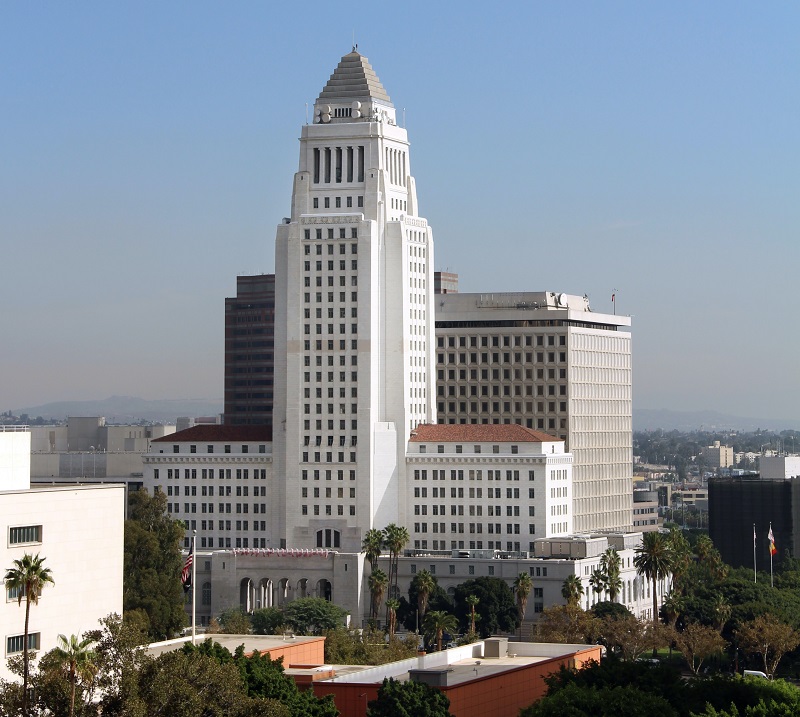
Los Angeles City Hall is the city’s city hall and the seat of both the mayor and the city council and their respective offices. At the same time, it is also one of Los Angeles’ most well-known and architecturally distinctive buildings.
The 138-meter-tall skyscraper was designed by architects John Parkinson, John C. Austin and Albert C. Martin, Sr. Construction began in 1926, and the town hall was completed in 1928 with an inauguration on 26 April. Today, City Hall’s height is surpassed by many modern skyscrapers, but in 1920s Los Angeles, City Hall was the first building to exceed the city’s 45 meter building height limit, which was otherwise in operation until 1957.
For decades, Los Angeles City Hall has been the absolute landmark of the city center, and despite the many newer high-rises, City Hall still stands as a stylistically unique building. You can take a closer look at the building from the observation deck on the 27th floor, from which there is a fine view of, among other things, Grand Park and the city’s modern centre.
A construction curiosity is that the Los Angeles City Hall was the world’s tallest building that was earthquake-proofed with base isolation, which popularly speaking keeps the actual building free from the foundation. It is a building adaptation that has been done on quite a few buildings in the western United States; in addition to Los Angeles City Hall, it has happened at the city halls of San Francisco and Pasadena, as well as the Salt Lake City and County Building in Utah’s capital.
Also known as the Los Angeles Cathedral, this cathedral is the Roman Catholic cathedral of Los Angeles and is thus the seat of the area’s archbishop. Its cathedral status is quite recent, having only formally opened in 2002 as a replacement for the Cathedral of Saint Vibiana, which was structurally damaged in the 1994 earthquake that struck the Californian metropolis.
The earthquake’s destruction of the church meant that it was decided to build a new cathedral rather than restore the old one, which has, however, been preserved. The result was the Cathedral of Our Lady of the Angels, which was built in the years 1998-2002.
It was the Spanish architect José Rafael Moneo who created the exciting building with breathtaking lines. The cathedral can accommodate 1,900 churchgoers and has a free-standing bell tower and a beautifully landscaped square in front of it. Inside, a large and extremely bright church room reveals itself beautifully.
Under the cathedral, a crypt has been arranged with countless niches for burials. At the mausoleum, Saint Vibiana was reburied after being moved from the city’s old cathedral. Saint Vibiana is the patron saint of the Archbishopric of Los Angeles. Actor Gregory Peck is one of the others buried here.
This park is Los Angeles’ largest, and in typical Hollywood style there is plenty to do in addition to enjoying the fine facilities and the views over the city. You can, for example, visit the museum Autry National Center (4700 Western Heritage Way), which depicts this part of the history of the western United States through exhibitions about the culture and way of life of cowboys and Indians.
Travel Town Museum (5200 Zoo Drive) is a railroad museum that celebrates the railroad history and major track constructions of the western United States. Many locomotives and wagons are on display here, and you can drive miniature trains. You will also find the Los Angeles Zoo and Botanical Garden (5333 Zoo Drive) in Griffith Park.
Griffith Park is also a large area with varied vegetation and hilly terrain that is good for many walks. In the lower part of the park, which lies immediately up the streets of Hollywood, there are green areas, while further up the hills towards, for example, the Griffith Observatory, there is more sparse growth and greater views of the landscape.
Wilshire Boulevard is one of the major and well-known traffic arteries in Los Angeles. It runs from central Los Angeles in the east to Santa Monica and the Pacific Ocean in the west. Wilshire Boulevard connects several important centers in Los Angeles, and the street is lined with famous buildings on several stretches; not least in downtown Los Angeles and along the so-called Miracle Mile.
Wilshire Boulevard dates back to the Native American population, who used the route as a road from the coast to the tarmac lakes that can still be seen. In Spanish times, the road connected the early pueblo to several ranches west of town. In recent times, the boulevard has been expanded and named after Henry Gaylord Wilshire, who donated a piece of land with the aim of establishing a new street that would bear his name.
Today, you can see many things along Wilshire Boulevard, and it might be an idea to choose some of the most interesting ones and concentrate on them. In downtown, some of Los Angeles’ tallest skyscrapers line the boulevard, and along the Miracle Mile you can see exciting museums and many buildings from the Art Deco era. You can also visit the Korean district, Koreatown, located between downtown and the Miracle Mile.
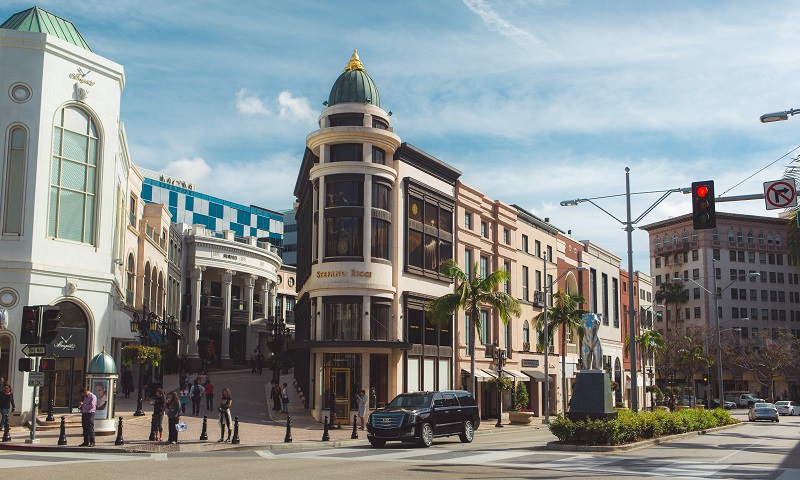
Rodeo Drive is America’s most fashionable shopping street with expensive international stores. The street is in the middle of the so-called Golden Triangle neighborhood in Beverly Hills, where you can go window shopping in one exclusive store after another. The street is also one of the opportunities to see a movie star on a shopping trip.
The street Sunset Boulevard runs from downtown Los Angeles through both Hollywood and Beverly Hills via the descent from the Santa Monica Mountains to the beautiful Pacific coast with the famous sunset.
There are several places worth seeing along the long boulevard. Film studios include the former Fox Network/KTTV Studios (5746 Sunset Boulevard), where Metromedia Square is now located, and KTLA Studios (5800 Sunset Boulevard), which was formerly home to Warner Bros. Studio.
Arclight Theater Hollywood (6360 Sunset Boulevard) from 1963 and Crossroads of the World Center (6671 Sunset Boulevard) from 1936 are two distinctive buildings. The pink and palm-fringed Beverly Hills Hotel (9641 Sunset Boulevard) also belongs to them.
Close to the coast is the Lake Shrine (17190 Sunset Boulevard), which is a very idyllic place, which, for example, Elvis Presley appreciated, and where part of Mahatma Gandhi’s ashes are kept.
The central part of Sunset Boulevard is between Havenhurst Drive and Sierra Drive. It is 2.4 kilometers long and is called the Sunset Strip. Here there are shops, restaurants and lots of billboards, and it is one of the places where you can be lucky enough to see some celebrities from Hollywood.
If you drive from east to west, the drive ends at the Pacific Coast Highway, which stretches along the Californian coast and through the southern suburbs of Los Angeles on the way to San Diego. At the end of Sunset Boulevard, there are many parking options, so it’s easy to enjoy the sea and the sunset if you time the trip right.
The Broad Museum is a contemporary art museum that opened in 2015. The museum is named after philanthropist Eli Broad, who funded the museum building to house and exhibit the collection of the Broad Art Foundation. The museum was designed by Diller Scofidio + Renfro, and the perforated metal exterior plays well against the Walt Disney Concert Hall, located across from the Broad Museum.
There are more than 2,000 works in the museum’s collection and there is an interesting permanent exhibition to see. You can thus experience a number of works by major contemporary artists such as Andy Warhol, Roy Liechtenstein and Jeff Koons.
This movie theater was built in the years 1930-1931, and it was one of the most elegantly decorated in Los Angeles at the time. The style was French Baroque with an opulent interior, which was said to be partly inspired by the Sun Kings’ Versailles on the outskirts of Paris.
The construction of the cinema with a capacity of 2,000 spectators took only about six months. Charlie Chaplin helped financially with the completion, so that the cinema could be ready for the premiere of his film City Lights, which was to be shown in January 1931. At the gala premiere on January 30, 1931, Albert Einstein was present with Chaplin, among others.
The Los Angeles Theater was one of the last theaters to be built on Broadway. It was open until 1994, and today the building is used for various events. Over time, the facade has been used in a number of different films and stands as one of Broadway’s icons from the theater world of the 20th century.
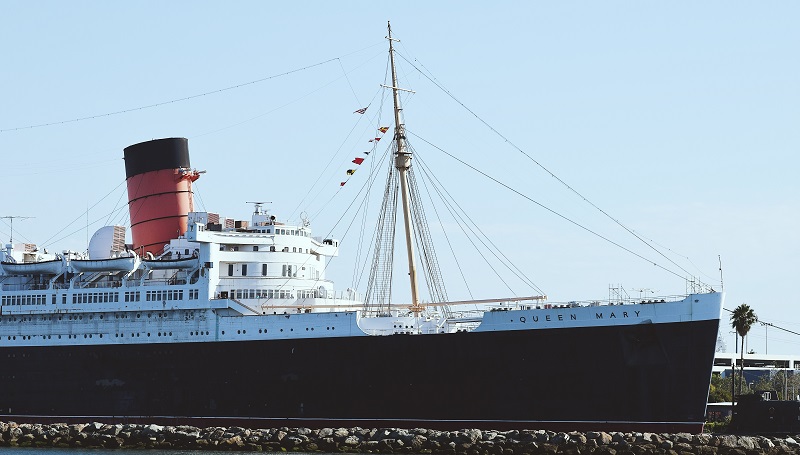
The era of the big American boats between Europe and the USA fostered many large luxury liners that sailed with emigrants, tourists etc. Among them was the RMS Queen Mary, which was ordered in 1929. The keel was laid the following year at the shipyard in Clydebank, Scotland, and in In 1934 the ship was finished.
Queen Mary sailed on her maiden voyage on 27 May 1936 for the shipping company Cunard, which with the ships Queen Mary and Queen Elizabeth would compete with contemporary German and French routes and liners.
The ship achieved the Blue Ribbon for fastest crossing of the Atlantic Ocean in August 1937 and held it except for a break in 1937-1938 until 1952, when the SS United States took over the record.
During World War II, the RMS Queen Mary was used as a troop ship, and after the end of the war it was again used as a passenger ship. After this it was in service until 1967. The last sailing trip was from Southampton on 31 October 1967 and the destination was Long Beach, where it has been since.
Today, the 310-metre-long and 81,961-tonne ship is fitted out as both a museum and a hotel. Here you can experience the beautiful lines of the time and the feeling of the shipping companies’ luxury liners from mainly the 1930s-1950s. You can of course also choose to stay at the ship’s hotel and experience the conditions up close.
Christ Cathedral is a large church building, also known as the Crystal Cathedral. It was built by the architect Philip Johnson, who used more than 10,000 mirror windows for the modern and unique building. The initiative for the construction was taken by the preacher Robert Schuller, who for decades has preached to millions of people worldwide. The Crystal Cathedral was consecrated in 1980.
There can be 3,000 listeners in the 12-storey high church, where everyone has been able to follow the session on a large Jumbotron screen, which is also known from sports arenas.
The organization behind the church went bankrupt in 2010, and since then the Catholic Church has acquired the Crystal Cathedral. They faced having to build a new cathedral, and instead the choice fell on this unique church, which as a Catholic cathedral bears the name Christ Cathedral/Christ Cathedral.
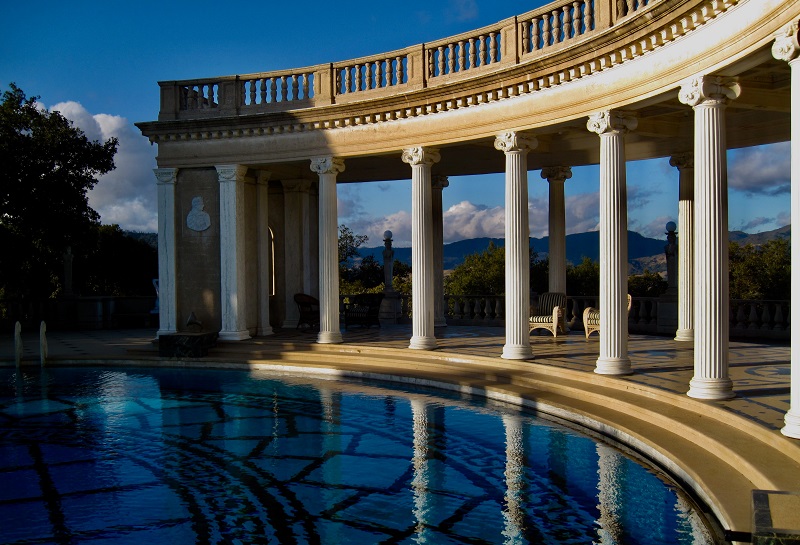
Along the Pacific coast you can drive on Highway 1 (California State Route 1), which between Los Angeles and San Francisco offers some of the world’s most beautiful and easily accessible coastal stretches. Rock formations in an almost endless variety offer new experiences after every turn. You can stop in many places, like in cozy and upscale coastal towns.
After just over 300 kilometers of driving north, at San Simeon you come to the most beautiful man-made work along the road, Hearst Castle (750 Hearst Castle Road). The castle on the mountain top was built from 1919 by the rich newspaper king William Randolph Hearst.
At the facility, earth was brought to the top of the mountain, trees were moved here, a zoo was established, and the castle itself was built in Spanish Renaissance style with Moorish inspiration. It was a huge investment, and here you can experience a Roman swimming pool, Roman baths and a great collection of art and antiques from primarily European history.

A little north of the urban area of Los Angeles is the J. Paul Getty Museum as the primary museum for the rich man and art lover J. Paul Getty’s large art collection. You can also see some of the Getty’s collection in the nearby Getty Villa, which is also worth a visit.
At the museum you can see European paintings from before 1900 and part of the Getty’s large collection of antiques. Artists include Titian, Peter Paul Rubens, Canaletto, Rembrandt, Édouard Manet, Auguste Renoir, Claude Monet, van Gogh and many more.
J. Paul Getty opened the museum in 1974, and it received $1.2 billion in 1982, giving it an economy unlike any other museum to expand its collection. Several lots of art were purchased and in 1997 the museum was moved to its current location.

Fashionable Malibu offers stunningly beautiful coastlines, cliffs and canyons and, of course, beautiful Californian beaches. Many wealthy people live here, who over time have appreciated the natural beauty and the location close to Los Angeles.
The Malibu area was opened in 1929, and today it is one of several cities along the Pacific coast west of Los Angeles. You can visit Malibu and continue along the famous Highway 1, which offers beautiful scenery on the way to the north and San Francisco.

Solvang is a Californian city that was founded by Danish immigrants in 1911. Since then, Solvang has been probably the best-known city that Danes have established in the USA. In Solvang, you can take a closer look at the architecture, which was inspired by the Denmark that the settlers had left in favor of life in America. Many chose to settle in Midwestern states such as Minnesota and Wisconsin, while quite a few others went to Utah.
However, there had been activity in Solvang since 1804, when Spaniards founded Mission Santa Inés as one of many Spanish missions in the southwestern part of what is now the United States. A small town grew up around the mission during the Mexican era, and it was called Santa Inés. With the US conquest of California in 1846-1847, Santa Inés was largely abandoned until the group of Danish-Americans arrived in 1911.
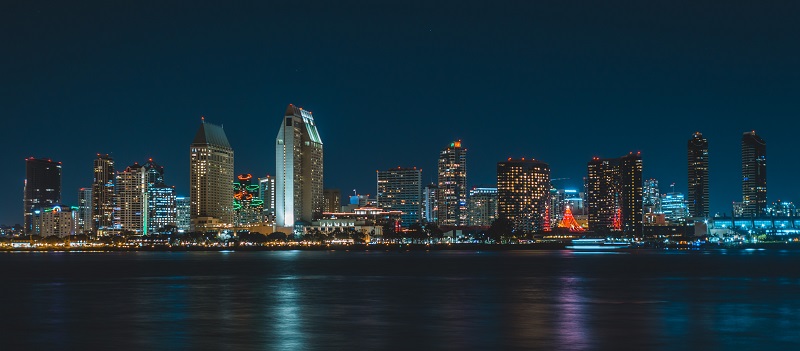
San Diego is a city in the southernmost part of California close to the Mexican border, and it is the city of relaxation with loads of attractions, a mild climate, kilometers of avenues with palm trees, sandy beaches and great sights for tourists. Alongside the large tourism industry, there is also a naval base and several information technology companies in the city.
San Diego’s historic sites are partly the Spanish Mission San Diego de Alcala (10818 San Diego Mission Road) and partly the old Spanish and European founded Old Town. The mission church was built by the Spanish as the first in California in 1769, and you can explore the history of the place in the visitor center. Old Town was primarily developed in the period 1821-1872.

San Francisco is considered one of America’s most charming and most beautiful metropolitan cities, and when you are there you immediately understand why. Besides the location, there are countless sights and things to do in both the city itself and in the beautiful scenery that surrounds the Californian city.
There are some landmarks and famous places you probably already know before coming to San Francisco. The hills and steep streets, the city’s cable cars, Alcatraz prison island and, not least, the Golden Gate Bridge are some of the highlights which have been seen in countless Hollywood movies, on photos and postcards and so on.
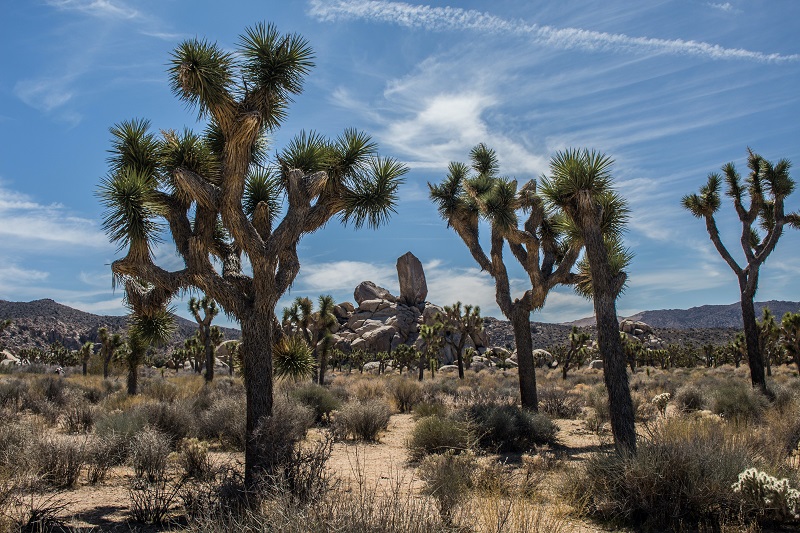
Joshua Tree is a national park, which is named after the tree yucca brevifolia, which in English is called Joshua Tree. The tree was once named after Joshua, and it was by Mormon settlers who believed that the tree resembled the biblical story of Joshua raising his hands in prayer.
You can drive into the national park in several places. The easiest and best for a general tour is from the northwest and the town of Joshua Tree. There is a visitor center for the park, and Park Boulevard starts from the visitor center, leading to and through Joshua Tree National Park.
By following Park Boulevard, you can take a nice trip of approximately 1.5 hours, to which you must add the time you stop in the park. Along the boulevard you can see countless Joshua trees and also the magnificent rock and desert landscapes of the park, which offers everything from plains to mountain formations.
It is recommended to stop at the places where there are walking routes and associated parking areas. Here you can walk along paths in the natural landscape, and the trips last approximately 30-60 minutes each. The natural places to stop are Hidden Valley and Barker Dam along Park Boulevard and then take a detour down Keys View Road to Keys View, which offers a stunning panoramic view of the Coachella Valley, Palm Springs and Mount San Jacinto.
Be aware that the temperature in summer is often extremely high and with the sun as well. It is something that requires precautions in the form of sunscreen, food and plenty of water in the car.

Palm Springs is one of several cities located in the Californian desert in the Coachella Valley east of Los Angeles. The city is known for its mild and warm climate, many activities and proximity to several beautiful places in nature.
Palm Springs became particularly well-known in the first half of the 20th century, when the city developed into a popular holiday destination. Mount San Jacinto to the west of the city ensured and still ensures visitors comfortable temperatures even in winter, which can be chilly on the Pacific Ocean. More and more hotels were built, and luxury attracted movie stars and other celebrities.
8500 Beverly Boulevard
beverlycenter.com
Beverly Center
bloomingdales.com
1065 Brea Mall
brea-mall.com
5675 E Telegraph Road
citadeloutlets.com
294 Fox Hills Mall
westfield.com/foxhills
317 S Broadway
grandcentralsquare.com
Beverly Center
macys.com
3200 Sepulveda Avenue
shopmanhattanvillage.com
One Mills Circle
ontariomills.com
20 City Boulevard W
blockatorange.com
189 The Grove Drive
thegrovela.com
101 Freeway/Lynn Road
shoptheoaksmall.com
10250 Santa Monica Boulevard
westfield.com/centurycity
Olvera St, Rodeo Drive, Sunset Blvd, Robertson Blvd, Melrose Ave, Abbot Kinney Blvd, Montana Ave, Third St, Hollywood Blvd, Highland Ave
Aquarium of the Pacific
Aquarium Way, Long Beach
aquariumofpacific.org
Disneyland
Disneyland Drive, Anaheim
disneyland.disney.go.com
Disney’s Hollywood Studios
Alameda Avenue
studioscentral.com
Los Angeles Zoo
5333 Zoo Drive
lazoo.org
Natural History Museum of Los Angeles County
900 Exposition Boulevard
nhm.org
RMS Queen Mary
1126 Queens Highway
queenmary.com
Travel Town Museum
4730 Crystal Springs
ci.la.ca.us/RAP/grifmet/tt
Universal Studios Hollywood
Universal City Plaza 100
universalstudioshollywood.com
Warner Bros Studio
3400 Riverside Drive
wbstudiotour.com
discoverlosangeles.com
lacity.org
Like other parts of the United States, the Los Angeles area has been inhabited for millennia by Native American tribes who migrated here from Siberia.
In 1542, the first Europeans came to the California coasts. That’s when Juan Rodriguez Cabrillo sailed to find a passage to Asia. In 1602, Captain Sebastián Vizcaíno laid anchor on the island of Santa Catalina, after which it would take 166 years before the next Europeans arrived.
Thus, the first real permanent European presence was in 1769, when the Spanish under the leadership of Gaspar de Portolà colonized the Californian area from the south. The group of about 60 people spent the night in the deserted landscape by a river, and the area’s character and potential for cultivation appealed to them: Here the basis for a real urban development was present.
The Catholic missionary Juan Crespi called the river El Rio de Nuestra Señora la Reyna de Los Angeles de Porciuncula, meaning the River to Our Lady, the Queen of the Angels of Porciuncula, and in this way the city got its later name.
In 1771, the Spaniards founded the Mission Church of San Gabriel in the area and later followed Spanish colonists from Mexico. They were to establish new cities in the name of the Spanish king. It was in 1781 that 12 families arrived and named their new city by the nearby river. The city’s name was shortened to Ciudad de Los Angeles.
Spanish dominance gradually weakened, and from 1821 Los Angeles became part of independent Mexico. For this reason, there was no major development in the area, and it was a small town that, after the US-Mexico War of 1846-1847, came on American hands with the rest of California. This happened formally in 1850.
In 1876, the railroad came to Los Angeles when Southern Pacific built a line from Tuscon in Arizona. The route continued to San Francisco, giving the city a central location for passenger and freight transportation. Over a decade, Los Angeles, among other things, exported oranges to the eastern United States.
In the 1880s, several cities were founded and established as part of Los Angeles; Hollywood, among others, emerged on the grounds of a ranch. The city flourished and by 1890 the population was 50,000.
In 1892, oil was found in the Los Angeles area, and in the following decades production increased to significant quantities, making Los Angeles an even more significant city for the United States economy.
In dry California, water was a scarce resource. Greater urban development required an increase in water supplies. It happened in 1913, when Irish William Mulholland completed the 400-mile aqueduct from the Owens Valley in central California to Los Angeles. The water supply led to a larger expansion of Los Angeles’ area in 1915.
In the roaring 1920s, more and more movie companies established themselves in the neighborhoods of Hollywood, and Los Angeles quickly became the center of the American film industry nicknamed Tinseltown. Large theaters shot up, and cultural life flourished in tandem with the great role films and movie stars have been playing ever since this beginning.
The 1920s were also the years in which Los Angeles attracted the rapidly growing civilian and military aviation industry, which over time has been a major locomotive of California’s boom as a high-tech industrial area, centered in Los Angeles and Silicon Valley, among others.
The city was gradually a million and its administration was established in impressive new buildings, not least the 1928 City Hall, and just four years later, the city became the world’s focus, as the Olympic Games were held here.
Hollywood and the Olympics were not alone in creating the city’s entertainment. In 1955, Walt Disney opened the beloved Disneyland theme park in suburban Anaheim, and it has been a model for many other parks in and outside Los Angeles ever since.
The city’s growth was unstoppable with a boom in population from year to year. Around 1960, 2.5 million people lived here in the now very sprawling urban area, which was very different from neighborhood to neighborhood.
The city’s problems with a large poor group of unemployed and run-down central housing districts in 1965 culminated in the six-day Watts uprising that turned the city’s streets into a fighting ground.
In 1984, Los Angeles hosted the Olympic Summer Games for the second time, and at the United States hosted the World Cup in soccer 10 years later, Los Angeles again added grass and stadium.
The 1990s became a time when Los Angeles again drew many headlines. The streets rioted in 1992 after the outcome of a lawsuit, and two years later, the city was hit by a powerful earthquake whose epicenter was in the city’s vicinity.
In recent decades, large sums have been invested in developing not least Central Downtown and Hollywood’s traditional main street, Hollywood Boulevard. It has created a great cultural boom in art, music, architecture and also for Los Angeles’ dream factories, where many films have been created over the years.
Today, Los Angeles is the United States second largest urban area with its more than ten million inhabitants, and there are activities 24 hours a day for visitors to the entertainment industry, the beaches and the beautiful nature of the western United States.
Overview of Los Angeles
Los Angeles is the place where the American dream is being lived. The beautiful location with warm climate and the Pacific Ocean helps to further sweeten the joyous life that prevails in the now very large American city.
When you talk about the city, you also think Hollywood and all the movie productions going on here. Everything is possible in the Californian metropolis, which you as a tourist get a good feel for in the city’s exclusive neighborhoods such as Hollywood and Beverly Hills.
About the travel guide to Los Angeles
Number of tours: 9 tours in the city + tours in the surrounding areas
Pages: 75
Published: 2019
Author: Stig Albeck
Publisher: Vamados.dk
Language: Danish
ISBN: 978-87-93491-05-2
About the travel guide The travel
guide to Los Angeles gives you an overview of the sights and experiences of the American city. Read about top sights and other sights, and buy a travel guide with tour suggestions and descriptions of all the city’s major churches, monuments, mansions, museums, etc.
Los Angeles is waiting for you, and at vamados.com you can also find cheap flights and great deals on hotels for your trip. You just select your travel dates and then you get flight and accommodation suggestions in and around the city.
Read more about Los Angeles and the United States
Travel guide about the United States: vamados.dk/usa City
tourism: www.discoverlosangeles.com City
tourism: www.lacity.org
California tourism: www.visitcalifornia.com
United States tourism: visittheusa.com
Metro: www.metro. net
California Railways: amtrakcalifornia.com
United States Railways: www.amtrak.com
Airports: www.lawa.org
John Wayne Orange Country Airport: www.ocair.com
Buy the travel guide
Click the “Put in cart” button to buy the travel guide. You will then be taken to the payment, where you enter the purchase and payment information. After completing the wizard payment, you will immediately receive a receipt with a link to download your purchase. You can download the wizard immediately or use the download link in the email later.
Use the travel guide
When you buy the travel guide to Los Angeles, you get the book online so you can have it on your phone, tablet or computer – and of course you can choose to print it. Use the maps and tour suggestions and you will have a good and content-rich journey.
Hollywood • Beverly Hills • Venice Beach • Movie Stars • American Dreams
Overview of Los Angeles
Los Angeles is the place where the American dream is being lived. The beautiful location with warm climate and the Pacific Ocean helps to further sweeten the joyous life that prevails in the now very large American city.
When you talk about the city, you also think Hollywood and all the movie productions going on here. Everything is possible in the Californian metropolis, which you as a tourist get a good feel for in the city’s exclusive neighborhoods such as Hollywood and Beverly Hills.
About the travel guide to Los Angeles
Number of tours: 9 tours in the city + tours in the surrounding areas
Pages: 75
Published: 2019
Author: Stig Albeck
Publisher: Vamados.dk
Language: Danish
ISBN: 978-87-93491-05-2
About the travel guide The travel
guide to Los Angeles gives you an overview of the sights and experiences of the American city. Read about top sights and other sights, and buy a travel guide with tour suggestions and descriptions of all the city’s major churches, monuments, mansions, museums, etc.
Los Angeles is waiting for you, and at vamados.com you can also find cheap flights and great deals on hotels for your trip. You just select your travel dates and then you get flight and accommodation suggestions in and around the city.
Read more about Los Angeles and the United States
Travel guide about the United States: vamados.dk/usa City
tourism: www.discoverlosangeles.com City
tourism: www.lacity.org
California tourism: www.visitcalifornia.com
United States tourism: visittheusa.com
Metro: www.metro. net
California Railways: amtrakcalifornia.com
United States Railways: www.amtrak.com
Airports: www.lawa.org
John Wayne Orange Country Airport: www.ocair.com
Buy the travel guide
Click the “Put in cart” button to buy the travel guide. You will then be taken to the payment, where you enter the purchase and payment information. After completing the wizard payment, you will immediately receive a receipt with a link to download your purchase. You can download the wizard immediately or use the download link in the email later.
Use the travel guide
When you buy the travel guide to Los Angeles, you get the book online so you can have it on your phone, tablet or computer – and of course you can choose to print it. Use the maps and tour suggestions and you will have a good and content-rich journey.

North of The Plaza is Olvera Street, which was the central street in the construction of the Spanish El Pueblo de Los Angeles. In its early days, Olvera Street was a busy street in the growing city, and many houses were built around it over time.
Today, the street has been transformed into a pedestrian street with an extensive street market. Here there are stalls, shops and eateries, and the whole is quite enjoyable. At the same time, it is possible to sense the historic Los Angeles behind the many stalls.
Among other things, you can see Los Angeles’ oldest house in Olvera Street. It is the Avila Adobe (10 Olvera Street), built in 1818 by Don Francisco Avila. The house is set up as a museum depicting life in Los Angeles in the 1840s.
The Sepulveda House (Olvera Street 12) near the Avila Adobe was built in 1887 and here you can find El Pueblo’s visitor center with general information and history of the site.
Los Angeles was founded by Spanish settlers in 1781, and it happened in the area around Olvera Street. The street and the neighborhood itself are not as they were then, but you can see more than 20 older renovated houses as well as some general inspiration from Spanish Mexico in what today stands as a living historical monument to the founding of the city.
The Plaza is the center of the small and atmospheric quarter. City life once unfolded on The Plaza, and around this area the earliest Los Angeles grew before the center of development moved south.
In El Pueblo there is also an active church, museums and several statues; among others by the Spanish King Carlos III, who was the monarch who ordered El Pueblo de Los Angeles founded.

Los Angeles City Hall is the city’s city hall and the seat of both the mayor and the city council and their respective offices. At the same time, it is also one of Los Angeles’ most well-known and architecturally distinctive buildings.
The 138-meter-tall skyscraper was designed by architects John Parkinson, John C. Austin and Albert C. Martin, Sr. Construction began in 1926, and the town hall was completed in 1928 with an inauguration on 26 April. Today, City Hall’s height is surpassed by many modern skyscrapers, but in 1920s Los Angeles, City Hall was the first building to exceed the city’s 45 meter building height limit, which was otherwise in operation until 1957.
For decades, Los Angeles City Hall has been the absolute landmark of the city center, and despite the many newer high-rises, City Hall still stands as a stylistically unique building. You can take a closer look at the building from the observation deck on the 27th floor, from which there is a fine view of, among other things, Grand Park and the city’s modern centre.
A construction curiosity is that the Los Angeles City Hall was the world’s tallest building that was earthquake-proofed with base isolation, which popularly speaking keeps the actual building free from the foundation. It is a building adaptation that has been done on quite a few buildings in the western United States; in addition to Los Angeles City Hall, it has happened at the city halls of San Francisco and Pasadena, as well as the Salt Lake City and County Building in Utah’s capital.
Also known as the Los Angeles Cathedral, this cathedral is the Roman Catholic cathedral of Los Angeles and is thus the seat of the area’s archbishop. Its cathedral status is quite recent, having only formally opened in 2002 as a replacement for the Cathedral of Saint Vibiana, which was structurally damaged in the 1994 earthquake that struck the Californian metropolis.
The earthquake’s destruction of the church meant that it was decided to build a new cathedral rather than restore the old one, which has, however, been preserved. The result was the Cathedral of Our Lady of the Angels, which was built in the years 1998-2002.
It was the Spanish architect José Rafael Moneo who created the exciting building with breathtaking lines. The cathedral can accommodate 1,900 churchgoers and has a free-standing bell tower and a beautifully landscaped square in front of it. Inside, a large and extremely bright church room reveals itself beautifully.
Under the cathedral, a crypt has been arranged with countless niches for burials. At the mausoleum, Saint Vibiana was reburied after being moved from the city’s old cathedral. Saint Vibiana is the patron saint of the Archbishopric of Los Angeles. Actor Gregory Peck is one of the others buried here.
This park is Los Angeles’ largest, and in typical Hollywood style there is plenty to do in addition to enjoying the fine facilities and the views over the city. You can, for example, visit the museum Autry National Center (4700 Western Heritage Way), which depicts this part of the history of the western United States through exhibitions about the culture and way of life of cowboys and Indians.
Travel Town Museum (5200 Zoo Drive) is a railroad museum that celebrates the railroad history and major track constructions of the western United States. Many locomotives and wagons are on display here, and you can drive miniature trains. You will also find the Los Angeles Zoo and Botanical Garden (5333 Zoo Drive) in Griffith Park.
Griffith Park is also a large area with varied vegetation and hilly terrain that is good for many walks. In the lower part of the park, which lies immediately up the streets of Hollywood, there are green areas, while further up the hills towards, for example, the Griffith Observatory, there is more sparse growth and greater views of the landscape.
Wilshire Boulevard is one of the major and well-known traffic arteries in Los Angeles. It runs from central Los Angeles in the east to Santa Monica and the Pacific Ocean in the west. Wilshire Boulevard connects several important centers in Los Angeles, and the street is lined with famous buildings on several stretches; not least in downtown Los Angeles and along the so-called Miracle Mile.
Wilshire Boulevard dates back to the Native American population, who used the route as a road from the coast to the tarmac lakes that can still be seen. In Spanish times, the road connected the early pueblo to several ranches west of town. In recent times, the boulevard has been expanded and named after Henry Gaylord Wilshire, who donated a piece of land with the aim of establishing a new street that would bear his name.
Today, you can see many things along Wilshire Boulevard, and it might be an idea to choose some of the most interesting ones and concentrate on them. In downtown, some of Los Angeles’ tallest skyscrapers line the boulevard, and along the Miracle Mile you can see exciting museums and many buildings from the Art Deco era. You can also visit the Korean district, Koreatown, located between downtown and the Miracle Mile.

Rodeo Drive is America’s most fashionable shopping street with expensive international stores. The street is in the middle of the so-called Golden Triangle neighborhood in Beverly Hills, where you can go window shopping in one exclusive store after another. The street is also one of the opportunities to see a movie star on a shopping trip.
The street Sunset Boulevard runs from downtown Los Angeles through both Hollywood and Beverly Hills via the descent from the Santa Monica Mountains to the beautiful Pacific coast with the famous sunset.
There are several places worth seeing along the long boulevard. Film studios include the former Fox Network/KTTV Studios (5746 Sunset Boulevard), where Metromedia Square is now located, and KTLA Studios (5800 Sunset Boulevard), which was formerly home to Warner Bros. Studio.
Arclight Theater Hollywood (6360 Sunset Boulevard) from 1963 and Crossroads of the World Center (6671 Sunset Boulevard) from 1936 are two distinctive buildings. The pink and palm-fringed Beverly Hills Hotel (9641 Sunset Boulevard) also belongs to them.
Close to the coast is the Lake Shrine (17190 Sunset Boulevard), which is a very idyllic place, which, for example, Elvis Presley appreciated, and where part of Mahatma Gandhi’s ashes are kept.
The central part of Sunset Boulevard is between Havenhurst Drive and Sierra Drive. It is 2.4 kilometers long and is called the Sunset Strip. Here there are shops, restaurants and lots of billboards, and it is one of the places where you can be lucky enough to see some celebrities from Hollywood.
If you drive from east to west, the drive ends at the Pacific Coast Highway, which stretches along the Californian coast and through the southern suburbs of Los Angeles on the way to San Diego. At the end of Sunset Boulevard, there are many parking options, so it’s easy to enjoy the sea and the sunset if you time the trip right.
The Broad Museum is a contemporary art museum that opened in 2015. The museum is named after philanthropist Eli Broad, who funded the museum building to house and exhibit the collection of the Broad Art Foundation. The museum was designed by Diller Scofidio + Renfro, and the perforated metal exterior plays well against the Walt Disney Concert Hall, located across from the Broad Museum.
There are more than 2,000 works in the museum’s collection and there is an interesting permanent exhibition to see. You can thus experience a number of works by major contemporary artists such as Andy Warhol, Roy Liechtenstein and Jeff Koons.
This movie theater was built in the years 1930-1931, and it was one of the most elegantly decorated in Los Angeles at the time. The style was French Baroque with an opulent interior, which was said to be partly inspired by the Sun Kings’ Versailles on the outskirts of Paris.
The construction of the cinema with a capacity of 2,000 spectators took only about six months. Charlie Chaplin helped financially with the completion, so that the cinema could be ready for the premiere of his film City Lights, which was to be shown in January 1931. At the gala premiere on January 30, 1931, Albert Einstein was present with Chaplin, among others.
The Los Angeles Theater was one of the last theaters to be built on Broadway. It was open until 1994, and today the building is used for various events. Over time, the facade has been used in a number of different films and stands as one of Broadway’s icons from the theater world of the 20th century.

The era of the big American boats between Europe and the USA fostered many large luxury liners that sailed with emigrants, tourists etc. Among them was the RMS Queen Mary, which was ordered in 1929. The keel was laid the following year at the shipyard in Clydebank, Scotland, and in In 1934 the ship was finished.
Queen Mary sailed on her maiden voyage on 27 May 1936 for the shipping company Cunard, which with the ships Queen Mary and Queen Elizabeth would compete with contemporary German and French routes and liners.
The ship achieved the Blue Ribbon for fastest crossing of the Atlantic Ocean in August 1937 and held it except for a break in 1937-1938 until 1952, when the SS United States took over the record.
During World War II, the RMS Queen Mary was used as a troop ship, and after the end of the war it was again used as a passenger ship. After this it was in service until 1967. The last sailing trip was from Southampton on 31 October 1967 and the destination was Long Beach, where it has been since.
Today, the 310-metre-long and 81,961-tonne ship is fitted out as both a museum and a hotel. Here you can experience the beautiful lines of the time and the feeling of the shipping companies’ luxury liners from mainly the 1930s-1950s. You can of course also choose to stay at the ship’s hotel and experience the conditions up close.
Christ Cathedral is a large church building, also known as the Crystal Cathedral. It was built by the architect Philip Johnson, who used more than 10,000 mirror windows for the modern and unique building. The initiative for the construction was taken by the preacher Robert Schuller, who for decades has preached to millions of people worldwide. The Crystal Cathedral was consecrated in 1980.
There can be 3,000 listeners in the 12-storey high church, where everyone has been able to follow the session on a large Jumbotron screen, which is also known from sports arenas.
The organization behind the church went bankrupt in 2010, and since then the Catholic Church has acquired the Crystal Cathedral. They faced having to build a new cathedral, and instead the choice fell on this unique church, which as a Catholic cathedral bears the name Christ Cathedral/Christ Cathedral.
Similar to Los Angeles Travel Guide